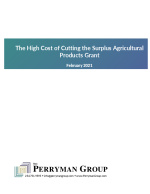The High Cost of Cutting the Surplus Agricultural Products Grant
Published on February 10, 2021

Since the COVID-19 pandemic began, the number of Texans seeking food bank assistance has risen 200%. This dramatic increase in food insecurity has caused immeasurable stress and suffering, eroding the health and wellbeing of people across the state. In the midst of this greatly increased need for help, the surplus agricultural products grant, a key aspect of food bank support, has been drastically cut. If this reduction remains in place, the opportunity to acquire almost 20 million pounds of healthy local produce will be lost. Hunger involves quantifiable economic costs in the form of increased health care and social service needs, inferior educational outcomes, and lost productivity. The Perryman Group estimates that cutting the surplus agricultural products grant would cost the state economy hundreds of millions of dollars over time, with economic harms spreading across the entire economy. Because economic activity generates taxes, the cut would also lead to reductions in State and local taxes. State costs for health care and education would also rise due to the effects of hunger.
The Perryman Group estimates that for every dollar of reduced funding, the State loses $1.04 in tax receipts over time, with increases in health care and education outlays pushing the total State cost per dollar of cuts to $2.81. Adding in the lost tax revenues to local governments yields total losses of $3.27 per dollar in cuts. The bottom line is quite simple: if people have access to quality food in times of need, the net benefits to the state both economically and fiscally greatly exceed the costs. Conversely, cuts which increase food insecurity will cause lasting harms. The choice is obvious.
For more details please refer to the full report.
- Tags: agriculture, farmers, impact analysis, food